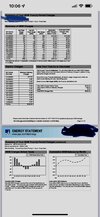Hi Folks,
I’ll paste my true up bill below.
Wondering what else I can tweak to improve next year. Overall I’m ok with the roughly $300 true up/overage.
1. Should I change my rate plan? I dunno. Would like to get some input from the experts. No electric car yet. Perhaps in 2023 when my cybertruck arrives
2. Live in NorCal. Should I get my panels cleaned? They are all on the second story, so this is not easy. If anyone has recommendations of folks/companies that do a good job, I’m all ears.
Cheers!!
I’ll paste my true up bill below.
Wondering what else I can tweak to improve next year. Overall I’m ok with the roughly $300 true up/overage.
1. Should I change my rate plan? I dunno. Would like to get some input from the experts. No electric car yet. Perhaps in 2023 when my cybertruck arrives
2. Live in NorCal. Should I get my panels cleaned? They are all on the second story, so this is not easy. If anyone has recommendations of folks/companies that do a good job, I’m all ears.
Cheers!!



